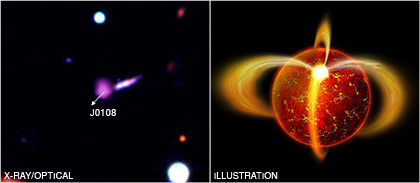A Young Pulsar Shows its Hand
A small, dense object only twelve miles in diameter is responsible for this beautiful X-ray nebula that spans 150 light years. At the center of this image made by NASA's Chandra X-ray Observatory is a very young and powerful pulsar, known as PSR B1509-58, or B1509 for short. The pulsar is a rapidly spinning neutron star which is spewing energy out into the space around it to create complex and intriguing structures, including one that resembles a large cosmic hand.
Live Webcast from Chandra's Control Center
On Friday, April 3rd, the public will have a chance to get an inside peek at how the Chandra X-ray Observatory is run. That's because we're participating in the "Around the World in 80 Telescopes" project that's part of the International Year of Astronomy's "100 Hours" program.
Erratic Black Hole Regulates Itself
This optical and infrared image from the Digitized Sky Survey shows the crowded field around the micro-quasar GRS 1915+105 (GRS 1915 for short) located near the plane of our Galaxy. The inset shows a close-up of the Chandra image of GRS 1915, one of the brightest X-ray sources in the Milky Way galaxy. This micro-quasar contains a black hole about 14 times the mass of the Sun that is feeding off material from a nearby companion star. As the material swirls toward the black hole, an accretion disk forms.
March's Mission Madness
You may have noticed that NASA is running an event mirroring the annual extravaganza that is the NCAA basketball tournament. Instead of selecting the basketball teams you think will win (I'm rooting for a certain Big 10 team myself), you vote for your favorite NASA mission.

Supersized Chandra Images (May Be) Near You
We've talked about one of our favorite IYA2009 projects here before - "From Earth to the Universe" - and now we want to give you an update. As of this month, FETTU, as we lovingly call it, is a reality. In the US, FETTU is currently appearing in the Tucson international airport in the baggage claim area.
Meet An Astronomer: Randall Smith
Dr. Randall Smith joins us this week for our "Meet an Astronomer" segment. Randall has worn several astronomical hats over the years, but right now he's putting most of his effort into working on the International X-ray Observatory. For those of you who haven't heard of it, IXO as it's known, is the planned next generation of X-ray telescope following along the lineage of Chandra, XMM-Newton and others. To make this happen, NASA, the European Space Agency (ESA), and JAXA, Japan's space agency, have joined forces to work on this proposed mission.
A Black Hole in Medusa's Hair
This composite image of the Medusa galaxy (also known as NGC 4194) shows X-ray data from NASA's Chandra X-ray Observatory in blue and optical light from the Hubble Space Telescope in orange. Located above the center of the galaxy and seen in the optical data, the "hair" of the Medusa -- made of snakes in the Greek myth -- is a tidal tail formed by a collision between galaxies. The bright X-ray source found towards the left side of Medusa's hair is a black hole.
Meet An Astronomer: Peter Edmonds
In the next installation of our new "Meet an Astronomer" series here on the Chandra blog, we introduce you to Dr. Peter Edmonds. Peter has been a part of our Education and Public Outreach group since 2003 and he has been an invaluable member of our team ever since. He helps find, track and develop the Chandra stories that we publicize, and he's instrumental in striking the right balance between scientific detail and public understanding.
Geriatric Pulsar Still Kicking
The composite image on the left shows an image from NASA's Chandra X-ray Observatory in purple and an optical image from the European Southern Observatory's Very Large Telescope (VLT) in red, blue and white. The Chandra source in the center of the image is the ancient pulsar PSR J0108-1431 (J0108 for short), located only 770 light years from us. The elongated object immediately to its upper right is a background galaxy that is unrelated to the pulsar. Since J0108 is located a long way from the plane of our galaxy, many distant galaxies are visible in the larger-scale optical image.
Announcing the 2009 Einstein Fellows
NASA announced today the selection of its 2009 Fellows, who are scientists who were recently (that is, since Jan. 1, 2006) awarded PhDs in astronomy, physics, or a related field. These new fellows can do research at any host institution in the US that they choose, and they represent some of the best and brightest in the field.



